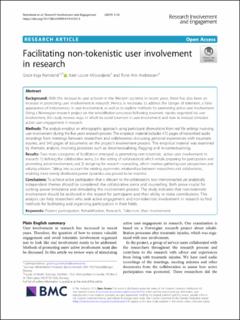| dc.contributor.author | Romsland, Grace Inga | |
| dc.contributor.author | Milosavljevic, Kate Louise | |
| dc.contributor.author | Andreassen, Tone Alm | |
| dc.date.accessioned | 2021-03-03T11:52:50Z | |
| dc.date.available | 2021-03-03T11:52:50Z | |
| dc.date.issued | 2019 | |
| dc.identifier.citation | Romsland, G.I., Milosavljevic, K.L. & Andreassen, T.A. (2019). Facilitating nontokenistic user involvement in research. Research Involvement and Engagement, 5,18, 1–12. | en_US |
| dc.identifier.uri | https://hdl.handle.net/11250/2731393 | |
| dc.description.abstract | Background
With the increase in user activism in the Western societies in recent years, there has also been an increase in promoting user involvement in research. Hence, is necessary to address the danger of tokenism, a false appearance of inclusiveness, in user involvement, as well as to explore methods for promoting active user involvement. Using a Norwegian research project on the rehabilitation processes following traumatic injuries organised via user involvement, this study reviews ways in which to avoid tokenism in user involvement and how to instead stimulate active user engagement in research.
Methods
The analysis employs an ethnographic approach using participant observations from real life settings involving user involvement during the five years research process. The empirical material includes 472 pages of transcribed audio recordings from meetings between researchers and collaborators discussing personal experiences with traumatic injuries, and 340 pages of documents on the project’s involvement process. This empirical material was examined by thematic analysis, involving processes such as decontextualising, flagging and re-contextualising.
Results
Two main categories of facilitation emerged as promoting non-tokenistic, active user involvement in research: 1) defining the collaborative arena, (i.e. the setting of collaboration) which entails preparing for participation and promoting active involvement, and 2) designing for research counselling, which involves gathering user perspectives and valuing criticism. Taking into account the existing asymmetric relationships between researchers and collaborators, enabling more evenly distributed power dynamics also proved to be essential.
Conclusions
To achieve active participation that is relevant to the collaborators, two interconnected yet analytically independent themes should be considered: the collaborative arena and counselling. Both prove crucial for curbing power imbalance and stimulating the involvement process. The study indicates that non-tokenistic involvement should be anchored in the respect for participants and their ability to make contributions. This analysis can help researchers who seek active engagement and non-tokenistic involvement in research to find methods for facilitating and organising participation in their fields. | en_US |
| dc.publisher | Research Involvement and Engagement | en_US |
| dc.rights | Navngivelse 4.0 Internasjonal | * |
| dc.rights.uri | http://creativecommons.org/licenses/by/4.0/deed.no | * |
| dc.subject | patient participation | en_US |
| dc.subject | rehabilitation | en_US |
| dc.subject | research | en_US |
| dc.subject | tokenism | en_US |
| dc.subject | user involvement | en_US |
| dc.subject | innovasjon | en_US |
| dc.title | Facilitating non-tokenistic user involvement in research | en_US |
| dc.type | Journal article | en_US |
| dc.source.volume | 5 | en_US |
| dc.source.journal | Research Involvement and Engagement | en_US |
| dc.identifier.doi | https://doi.org/10.1186/s40900-019-0153-3 | |
| dc.source.articlenumber | 18 | en_US |

